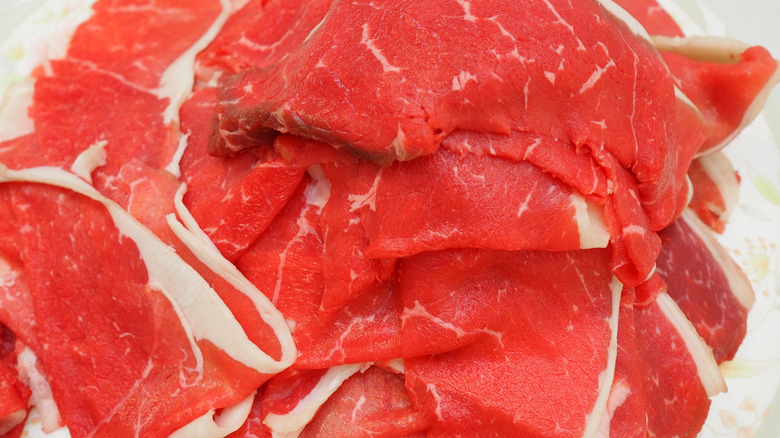The Mandoline Hack For Ultra Thin Meat Slices
When you need very thinly sliced proteins, even a super sharp Japanese-style chef's knife may not suffice. A tool you might have previously reserved for homemade potato chips, picture-perfect radishes, or shaved Brussels sprouts is actually perfect for preparing meat as well. You need a mandoline.
Mandolines can be either handheld or supported by a sort of kickstand. The cutting edge may feature a single setting, a few different plates, or an adjustable width blade. They can be used to cut coins, planks, matchsticks, waffle fries, or julienned pieces. But no matter how simple or elaborate, a mandoline blade is extremely sharp. Since they can be used for cutting firm vegetables like potatoes, fennel, turnips, and so on, they are definitely sturdy enough to handle meat.
@gaming_foodie Not sure if this is "professional chef" approved but it's Vietnamese mom & dad approved so it's alllll good with me! #kitchen hack #mandoline
For shaving meat, you will just need a basic flat slicing blade. To ensure the process goes as smoothly as possible, start by freezing a boneless piece of protein. This method works for raw, deli-style, or cured meats, but regardless of the type, freezing it will make it easier to cut. You don't want it completely rock hard, though — about half an hour or so should suffice. Attach the pronged hand guard to the protein, and shave it at your desired thickness!
Mandoline safety essentials
Mandolines are notoriously dangerous. After all, using one involves combining an unprotected blade, pressure, and fingers, which can result in a very Halloween-like scenario if you aren't careful. Start by setting up your mandoline on a stable surface, such as a cutting board with a damp towel underneath to prevent it from sliding around.
Applying force to the ingredient you are cutting with your palm, instead of your fingers, is a good practice. However, the hand guard that came with your device is the safest option by far. Don't skip it when trying out this hack. You can also use cut-resistant gloves for additional safety. Hold the tool firmly with your non-dominant hand, and hold the meat (with the guard attached to it) with your dominant hand. Remember that a mandoline will only cut in a downward motion, so you will need to lift the piece of meat and slide it back to the top of the plank to cut each new slice. Resist the urge to forgo the hand guard to shave down the very end of the piece. Instead, cut it with a knife or reserve it for another use.
Take care when washing and storing your mandoline as well. Even when you are not actively using it, the blade can still cause harm if it is hidden under dirty dishes, or stuffed haphazardly into a drawer.
Meats that benefit from a pass through the mandoline
No matter what protein you are using, you should definitely be cutting it against the grain. The grain refers to the straight fibers that run parallel across the muscle. Identify them, and then angle the piece so that you are cutting perpendicular to them. By cutting across those fibers, you are shortening them, which makes for an easier-to-chew bite.
This mandoline hack is the secret to cutting razor-thin eye of round for Vietnamese pho, perfectly shaved boneless ribeye for Korean bulgogi, or a pile of finely sliced sirloin for a decadent Philly cheesesteak. You can even thinly slice tofu or tempeh, and toss the pieces in olive oil, ground coriander, paprika, and cinnamon before roasting for a Middle Eastern shawarma-inspired preparation.
Try making a homemade version of your favorite deli meats by baking off boneless, skinless chicken breast with Cajun seasoning, or a pork tenderloin with lots of black pepper. Once cooked and cooled, let them sit in the freezer for a bit, and then slice. You can also use the mandoline to perfectly cut that special occasion cured sausage or prosciutto. Just take your time, exercise caution, and start seriously upgrading your at-home protein game.



